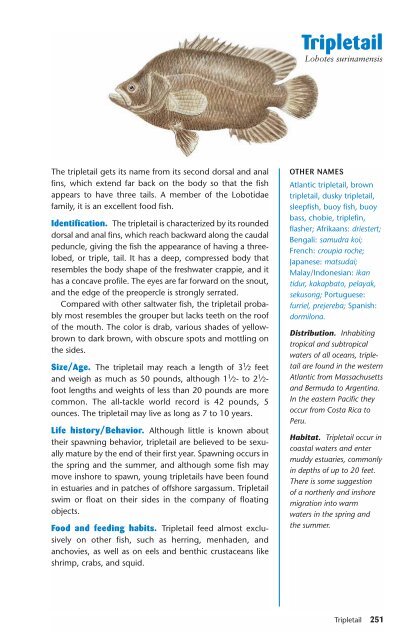Ken Schultz's Field Guide to Saltwater Fish - Macaw Pets store
Ken Schultz's Field Guide to Saltwater Fish - Macaw Pets store
Ken Schultz's Field Guide to Saltwater Fish - Macaw Pets store
You also want an ePaper? Increase the reach of your titles
YUMPU automatically turns print PDFs into web optimized ePapers that Google loves.
The tripletail gets its name from its second dorsal and anal<br />
fins, which extend far back on the body so that the fish<br />
appears <strong>to</strong> have three tails. A member of the Lobotidae<br />
family, it is an excellent food fish.<br />
Identification. The tripletail is characterized by its rounded<br />
dorsal and anal fins, which reach backward along the caudal<br />
peduncle, giving the fish the appearance of having a threelobed,<br />
or triple, tail. It has a deep, compressed body that<br />
resembles the body shape of the freshwater crappie, and it<br />
has a concave profile. The eyes are far forward on the snout,<br />
and the edge of the preopercle is strongly serrated.<br />
Compared with other saltwater fish, the tripletail probably<br />
most resembles the grouper but lacks teeth on the roof<br />
of the mouth. The color is drab, various shades of yellowbrown<br />
<strong>to</strong> dark brown, with obscure spots and mottling on<br />
the sides.<br />
Size/Age. The tripletail may reach a length of 3 1 ⁄2 feet<br />
and weigh as much as 50 pounds, although 1 1 ⁄2- <strong>to</strong> 2 1 ⁄2foot<br />
lengths and weights of less than 20 pounds are more<br />
common. The all-tackle world record is 42 pounds, 5<br />
ounces. The tripletail may live as long as 7 <strong>to</strong> 10 years.<br />
Life his<strong>to</strong>ry/Behavior. Although little is known about<br />
their spawning behavior, tripletail are believed <strong>to</strong> be sexually<br />
mature by the end of their first year. Spawning occurs in<br />
the spring and the summer, and although some fish may<br />
move inshore <strong>to</strong> spawn, young tripletails have been found<br />
in estuaries and in patches of offshore sargassum. Tripletail<br />
swim or float on their sides in the company of floating<br />
objects.<br />
Food and feeding habits. Tripletail feed almost exclusively<br />
on other fish, such as herring, menhaden, and<br />
anchovies, as well as on eels and benthic crustaceans like<br />
shrimp, crabs, and squid.<br />
Tripletail<br />
Lobotes surinamensis<br />
OTHER NAMES<br />
Atlantic tripletail, brown<br />
tripletail, dusky tripletail,<br />
sleepfish, buoy fish, buoy<br />
bass, chobie, triplefin,<br />
flasher; Afrikaans: driestert;<br />
Bengali: samudra koi;<br />
French: croupia roche;<br />
Japanese: matsudai;<br />
Malay/Indonesian: ikan<br />
tidur, kakapba<strong>to</strong>, pelayak,<br />
sekusong; Portuguese:<br />
furriel, prejereba; Spanish:<br />
dormilona.<br />
Distribution. Inhabiting<br />
tropical and subtropical<br />
waters of all oceans, tripletail<br />
are found in the western<br />
Atlantic from Massachusetts<br />
and Bermuda <strong>to</strong> Argentina.<br />
In the eastern Pacific they<br />
occur from Costa Rica <strong>to</strong><br />
Peru.<br />
Habitat. Tripletail occur in<br />
coastal waters and enter<br />
muddy estuaries, commonly<br />
in depths of up <strong>to</strong> 20 feet.<br />
There is some suggestion<br />
of a northerly and inshore<br />
migration in<strong>to</strong> warm<br />
waters in the spring and<br />
the summer.<br />
Tripletail 251


